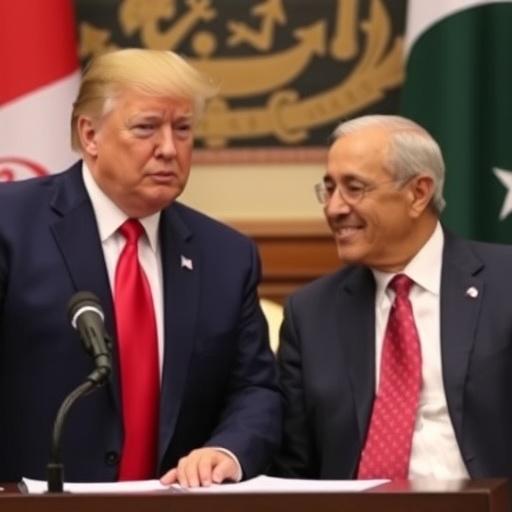Trump Vows Swift Resolution to Afghanistan-Pakistan Crisis Amid Tense Border Peace Talks
In a bold declaration from the White House, President Donald Trump has promised to resolve the escalating Afghanistan-Pakistan crisis “very quickly,” injecting U.S. diplomatic muscle into fragile peace talks strained by recent deadly border clashes. The announcement comes as tensions simmer along the volatile Durand Line, where cross-border skirmishes have claimed dozens of lives and threatened to unravel years of hard-won progress toward regional stability.
Trump‘s pledge, delivered during a high-stakes press briefing on Thursday, underscores America’s renewed commitment to South Asian security at a time when both nations grapple with internal insurgencies and external pressures. “We’ve got great people working on this, and it’s going to be solved fast—believe me,” Trump stated, emphasizing his administration’s hands-on approach to mediating the dispute. This intervention arrives amid reports of intensified military posturing on both sides of the border, raising fears of a broader conflict that could draw in global powers.
The crisis has roots in longstanding territorial disputes, but recent escalations—triggered by a series of ambushes and artillery exchanges—have pushed Afghanistan and Pakistan to the negotiating table in Doha, Qatar. With over 50 deaths reported in the past month alone, according to United Nations monitors, the stakes couldn’t be higher. Trump’s vow signals a potential shift in U.S. policy, moving from observer status to active broker in what many analysts call one of the world’s most intractable border feuds.
Deadly Border Clashes Ignite Fresh Tensions Along Durand Line
The spark for the current Afghanistan-Pakistan crisis ignited on the rugged frontiers of Khyber Pakhtunkhwa and eastern Afghanistan, where a deadly ambush last week left 28 Pakistani soldiers dead. Eyewitness accounts describe militants crossing the porous Pakistan border under cover of night, launching rocket-propelled grenades at a military outpost near Torkham. In retaliation, Pakistani forces shelled Afghan positions, killing at least 15 civilians and displacing thousands from nearby villages.
These clashes are not isolated incidents. Data from the South Asian Terrorism Portal indicates a 40% surge in cross-border incidents since the start of the year, with 142 attacks recorded in the first half of 2023 alone. The Durand Line, a 2,640-kilometer stretch drawn by British colonial rulers in 1893, remains a flashpoint, unrecognized by Afghanistan as its official border and frequently violated by Taliban-linked insurgents seeking safe havens.
Pakistan‘s military chief, General Asim Munir, blamed “Afghan-based terror networks” for the assault, vowing a “decisive response.” Meanwhile, Afghanistan‘s interim government, led by figures aligned with the Taliban, accused Pakistan of airstrikes that violated sovereignty. “These provocations undermine our shared fight against extremism,” said Afghan spokesperson Zabihullah Mujahid in a rare public statement.
Humanitarian fallout has been severe. The International Committee of the Red Cross reports over 10,000 internally displaced persons in the affected regions, with aid convoys struggling to reach remote areas amid ongoing hostilities. Economically, the closures of key border crossings like Chaman and Torkham have disrupted $2.5 billion in annual trade, exacerbating food shortages and inflating prices in border towns.
Trump’s Washington Pledge Signals U.S. Push for Rapid Diplomacy
President Trump‘s intervention marks a pivotal moment in U.S. engagement with the Afghanistan-Pakistan crisis. Speaking to reporters in the East Room, flanked by Secretary of State Mike Pompeo and National Security Advisor John Bolton, Trump outlined a multifaceted strategy. “Afghanistan and Pakistan are like brothers who’ve had a family feud too long. We’re stepping in to mediate, and it’ll be quick—very quick,” he asserted, drawing parallels to his administration’s brokered deals in the Middle East.
Behind the rhetoric, details emerge of a U.S.-led diplomatic surge. Sources within the State Department reveal plans to host a trilateral summit in Washington next month, inviting Pakistan‘s Prime Minister Imran Khan and Afghanistan‘s top negotiators. This follows a series of covert shuttle diplomacy, including Pompeo’s recent visit to Islamabad, where he reportedly secured assurances on de-escalation.
Trump‘s approach contrasts with the Obama-era “light footprint” policy, emphasizing direct leverage through aid and military cooperation. The U.S. provides $1.2 billion annually in security assistance to Pakistan and supports Afghanistan‘s counterterrorism efforts with drone operations and training. Critics, however, warn that Trump‘s timeline may be overly optimistic. “Resolving decades-old grievances in weeks is ambitious at best,” noted Michael Kugelman, a South Asia expert at the Wilson Center.
Public reaction in the U.S. has been mixed. Supporters praise Trump‘s decisiveness, with social media buzzing under hashtags like #TrumpFixesAfPak. Yet, congressional Democrats question the feasibility, citing the 2021 U.S. withdrawal from Afghanistan as a lingering scar on American credibility in the region.
Key Figures Navigate Rocky Terrain in Doha Peace Talks
The peace talks in Doha represent a fragile lifeline amid the crisis. Convened under the auspices of the Qatar government, the negotiations bring together delegations from Afghanistan‘s Taliban leadership and Pakistan‘s Inter-Services Intelligence (ISI) representatives. At the forefront is Mullah Abdul Ghani Baradar, the Taliban’s chief negotiator, whose past imprisonment in Pakistan adds layers of personal animosity to the proceedings.
On the Pakistan side, Foreign Minister Shah Mahmood Qureshi leads the team, armed with intelligence dossiers on cross-border militancy. Sessions have focused on confidence-building measures, such as joint patrols along the border and intelligence-sharing protocols. A breakthrough came last Tuesday when both sides agreed to a 72-hour ceasefire, allowing humanitarian access to affected areas.
Quotes from the talks paint a picture of cautious optimism. “We seek not victory, but coexistence,” Baradar told mediators, according to leaks reported by Al Jazeera. Qureshi echoed this, stating, “Pakistan stands ready to turn the page on this chapter of discord.” Yet, underlying distrust persists; Afghanistan accuses Pakistan of harboring Haqqani network operatives, while Islamabad points to Kabul’s lax border controls.
International observers, including envoys from China and India—key regional stakeholders—have joined as guarantors. China’s Belt and Road Initiative, which traverses Pakistan, adds economic incentives for resolution, with Beijing pledging $500 million in reconstruction aid if talks succeed. India’s concerns over Pakistan-backed militancy in Kashmir further complicate the dynamics, making the Doha forum a geopolitical chessboard.
Progress has been incremental. Agenda items include demilitarizing border zones, establishing a joint commission for dispute resolution, and addressing refugee flows—over 1.4 million Afghans reside in Pakistan, per UNHCR figures. Despite setbacks, like a walkout by Afghan delegates over alleged Pakistani shelling, mediators report “glimmers of compromise.”
Historical Shadows Loom Over the Afghanistan-Pakistan Border Feud
To understand the depth of the Afghanistan-Pakistan crisis, one must delve into its colonial origins. The Durand Line, imposed in 1893, bisected Pashtun ethnic territories, sowing seeds of resentment that persist today. Afghanistan‘s kings repeatedly challenged the boundary, leading to wars in 1919 and 1949. Post-1947 partition, Pakistan inherited the line, but Kabul’s irredentist claims fueled proxy conflicts.
The Soviet invasion of Afghanistan in 1979 transformed the border into a jihadist corridor, with Pakistan serving as a launchpad for mujahideen fighters backed by the CIA. The 1990s rise of the Taliban—nurtured in Pakistani madrassas—intensified ties, culminating in the 2001 U.S.-led ouster. Even after, the Haqqani network and Tehrik-i-Taliban Pakistan (TTP) exploited the frontier, launching attacks that killed thousands.
Statistics underscore the toll: Since 2001, border violence has claimed over 5,000 lives, according to the Costs of War Project at Brown University. U.S. drone strikes, numbering 430 in Pakistan alone, have eliminated high-value targets but also fueled anti-American sentiment. The 2021 Taliban takeover in Afghanistan reignited old patterns, with TTP attacks in Pakistan surging 60% in 2022.
Regional powers have meddled extensively. Pakistan‘s “strategic depth” doctrine views Afghanistan as a buffer against India, while Kabul courts Tehran and Delhi for balance. Trump‘s 2017 South Asia strategy aimed to pressure Pakistan on militancy, suspending $300 million in aid—a move that strained ties but prompted ISI reforms.
Today, economic interdependence offers hope. The China-Pakistan Economic Corridor (CPEC) extends to Afghanistan, promising $62 billion in infrastructure. Yet, without resolving the crisis, such initiatives risk derailment, perpetuating a cycle of instability that hampers development for 240 million people across both nations.
U.S. Mediation Opens Doors to Broader Regional Stability
Looking ahead, Trump‘s vow could catalyze a turning point in the peace talks, potentially reshaping South Asia’s security landscape. Successful mediation might yield a formalized border management pact, reducing incursions by 70%, as projected by RAND Corporation analysts. This would bolster counterterrorism efforts, allowing resources to shift from defense to reconstruction—Afghanistan needs $15 billion annually for basic services, per World Bank estimates.
For Pakistan, resolution means stabilizing its western flank, freeing the military to address eastern threats from India and domestic insurgencies. Economically, reopened borders could boost bilateral trade to $5 billion by 2025, fostering joint ventures in mining and energy.
Challenges remain daunting. The Taliban’s governance in Afghanistan faces internal fractures, with factions resisting concessions. Pakistan‘s deep-state elements may sabotage talks to maintain influence. Trump‘s “America First” lens risks prioritizing quick wins over sustainable peace, potentially overlooking women’s rights and minority protections in Afghanistan.
Yet, momentum builds. Upcoming U.N. Security Council resolutions could endorse the Doha process, with sanctions relief for compliant parties. As Trump prepares for his summit, the world watches: Can U.S. diplomacy tame this enduring crisis, or will history repeat along the Durand Line? The path forward hinges on trust-building, economic incentives, and unwavering international support, promising a more secure tomorrow for Afghanistan, Pakistan, and beyond.










